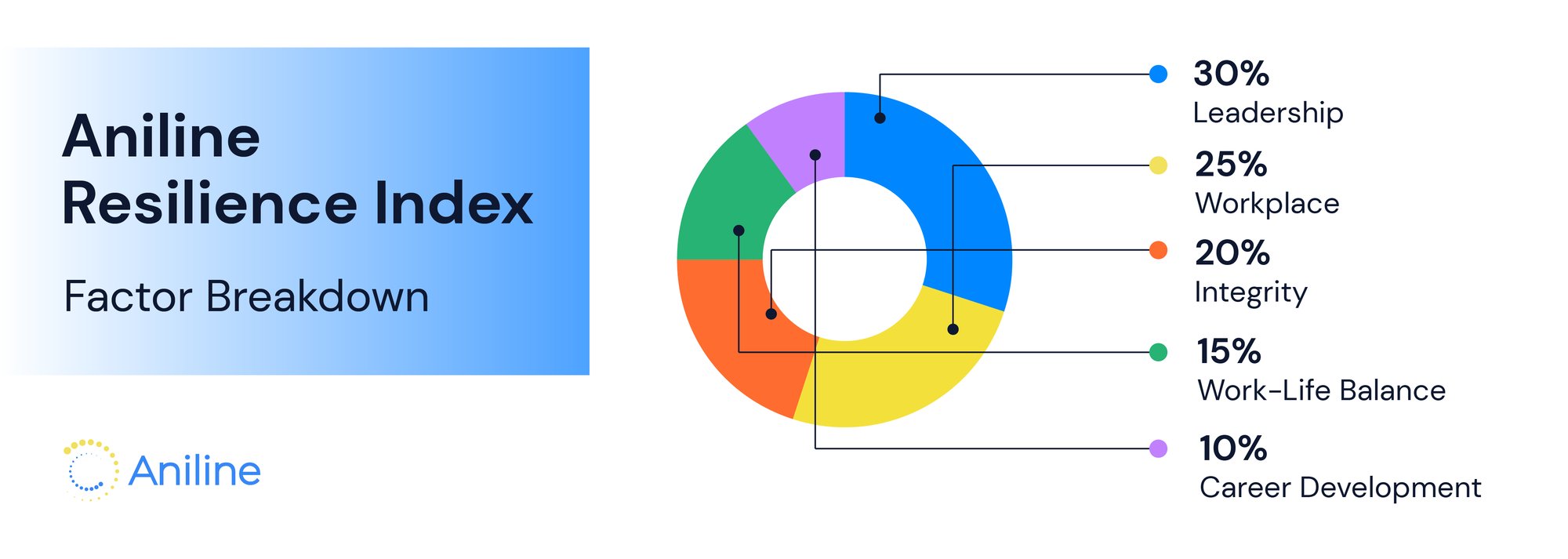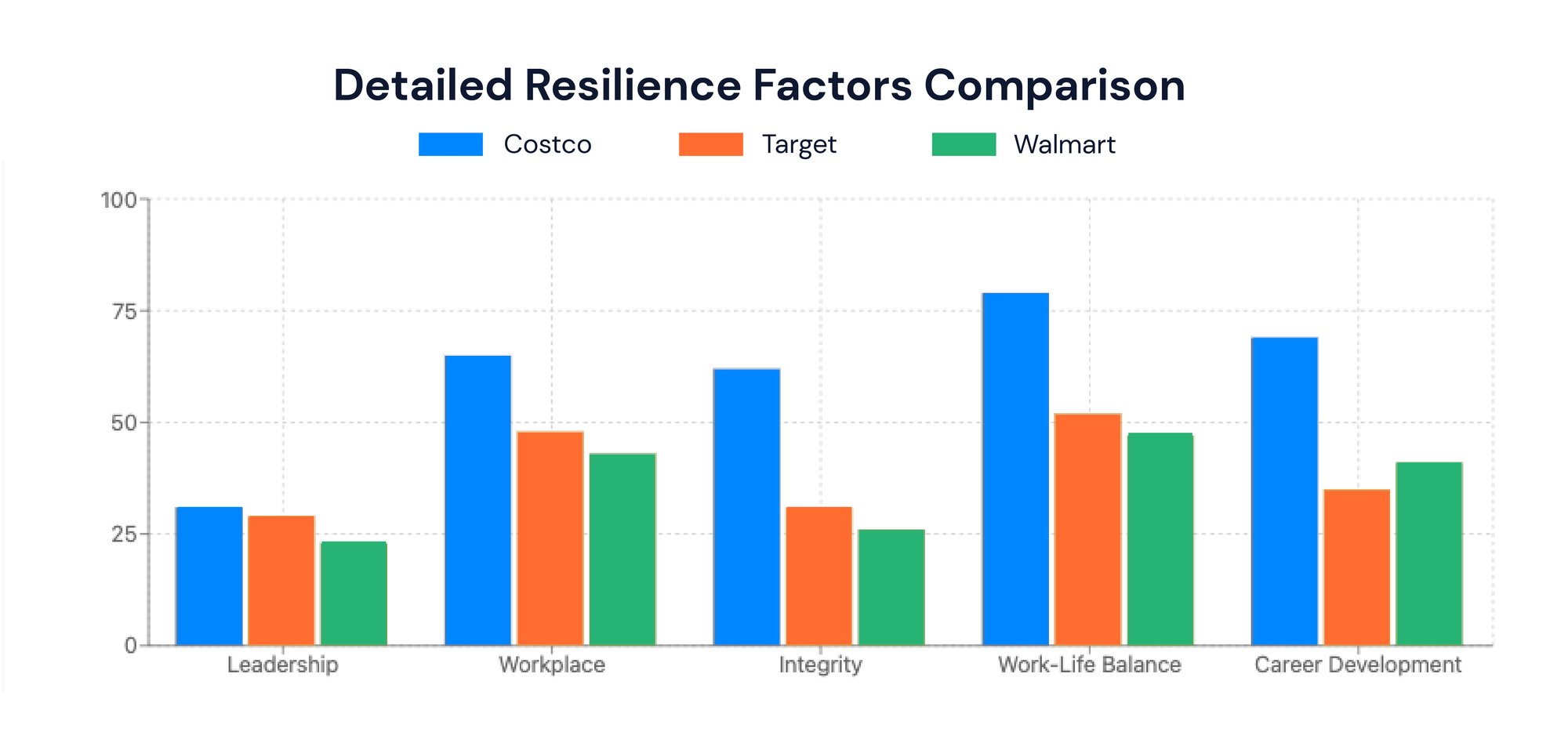Double Jeopardy: How Tariffs Amplify Retail's $50B Talent Crisis - The Resilience Imperative
What happens when America's largest retailers face simultaneous threats that could undermine their very foundations? The Answer is, it’s all about resilience. According to Aniline's proprietary Resilience Index, major retailers like Target, Walmart, and Costco are dangerously unprepared for the perfect storm brewing in 2025: crippling workforce instability colliding with tariffs and significant exposure to China exports. Aniline’s data-driven analysis measures and highlights the importance of organizational resilience—the capacity to maintain operations during market disruptions—can vary significantly between apparent industry peers, creating both risks and opportunities that traditional financial metrics fail to capture.
"Resilience is more than just the ability to recover quickly. In business, resilience means dealing with adversity and shocks, and continuously adapting for growth. Truly resilient organizations don't just bounce back better; they actually thrive in hostile environments." — McKinsey & Company
Measuring The Resilience Gap: Numbers Don't Lie
Aniline’s *Resilience Index based on our proprietary database of over 1 billion+ employee reviews and perceptions provide unparalleled insight in an organization's ability to withstand both external and internal shocks through five key factors: Leadership Effectiveness, Workplace Environment, Integrity, Work-Life Balance, and Career Development. By analyzing over 1 billion employee data points and combined with publicly available data (e.g., SEC filings), Aniline’s methodology identifies strengths that enable industry leaders to make share gains during shock as well as, critically, vulnerabilities that would impair response to both general and industry-specific shock events.
The results in retail are striking (and suggest importance for additional key Tariff exposed industries like Auto and Technology):
- Costco: 57/100 (Moderate Resilience) – Strongest in employee retention driven by highly scored employee benefits (79/100) and compensation structures (69/100)
- Target: 39/100 (Low Resilience) – Concerning weaknesses in leadership effectiveness (29/100) and low integrity scores from employees (31/100)
- Walmart: 36/100 (Low Resilience) – Significant vulnerabilities in leadership effectiveness – especially at regional levels (23/100) and, like Target, employee perception of integrity (26/100)
Despite similar market conditions, these retailers demonstrate dramatically different capacities to navigate dual crises. The question isn't just which retailers will survive—but which will transform these sector-wide headwinds into sustainable competitive advantages.

When Leadership Fails: The Common Vulnerability
What's the single greatest resilience risk across all three retail giants? Leadership quality consistently ranks as their weakest point, with scores ranging from just 23 to 31 out of 100.
Target's leadership demonstrates significant weaknesses with a concerning disconnect between corporate leadership values and implementation at the store level.
"Management constantly changes the goal post and then doesn't effectively communicate." (Employee Engagement Report)
Decision-making is highly hierarchical and "top-down” and employees don’t always understand and are often confused by the highly "metrics-driven" approach – with “minimal input from frontline employees”, creating a rigid hierarchy that would likely hamper rapid responses during crisis situations.
This connects directly to McKinsey's findings that "dynamic decision making" is essential for organizational agility. According to McKinsey, "In times of crisis, any uncertainty about who has the final say can cause costly delays. To accelerate good decision making, leaders should distinguish between types of decisions and the level of risk that may be involved. "Employee quotes and experience tell the story:
"Leadership is looking out for, and prioritizing, themselves, not you." (Target Leadership Effectiveness Report, Company Performance Report)
"Management is a nightmare—no communication at all." (Walmart Leadership Effectiveness Report)
"If a manager or supervisor doesn't like you, they will make your job hard." (Costco Leadership Effectiveness Report)
When tariffs hit supply chains and workforce instability peaks simultaneously, these leadership weaknesses could prove catastrophic.
The Tariff Threat Multiplier
For large retailers that are heavy importers of foreign produced products, tariff implementations will severely test organizational resilience. Companies with centralized, metrics-driven decision-making processes and reported communication gaps would struggle to implement timely pricing adjustments and sourcing alternatives. As Costco's Resilience Report notes, "With employees already citing 'conflicting directives' and 'inconsistent management practices,' the organization would struggle to coordinate cohesive responses to tariff shocks that require simultaneous adjustments across purchasing, pricing, and inventory management." – greatly hampering response times and effectiveness, which would result in substantial lost sales and earnings shortfalls.
The double jeopardy emerges when tariff pressures amplify existing operational weaknesses, creating a cascading effect that compromises both customer experience and financial performance.

Five Data-Driven Approaches for Assessing Who is Well Positioned and Who Is Not
What can retailers do to build resilience before the perfect storm hits? Aniline's analysis reveals five critical areas to understand deeper:
- Leadership Effectiveness and Potential Enhancements: Leverage employee feedback to understand which processes need enhancements in these volatile times, e.g., to potentially enhance key leadership practices through comprehensive training focused on consistent communication, fair treatment, and crisis management. Establish clear accountability metrics that evaluate managers on both leadership behaviors and performance outcomes.
"For Target to make claims of being an inclusive company, there is a LOT of slack that they need to clean up." (Company Culture Report)
- Retention and Operational Consistency: Understand root cause drivers and address chronic understaffing through systematic workload analysis to determine appropriate staffing levels across departments. Adjust scheduling practices to ensure adequate coverage while maintaining work-life balance benefits.
"The store is always chronically understaffed regardless of which department you work in." (Employee Workload and Well-Being Report)
- Integrity Gaps and Challenges: Respond to employee feedback on the lack of transparent, merit-based assessment systems to address perceptions of favoritism, which based on Aniline data is particularly prevalent in the high touch, in-store retail environment. Ensure consistent application of promotion criteria across all locations to build trust essential for crisis response.
"There is favoritism, and you will not be promoted or considered for projects unless you are a manager favorite." (Target Leadership Performance Report)
- Enhance Cross-Level Communication: Develop robust feedback mechanisms that ensure employee concerns reach decision-makers and receive timely responses. Create standardized communication protocols across all organizational levels to reduce conflicting messages during crisis events.
"Feedback and concerns raised by employees were often ignored or dismissed." (Target Leadership Performance Report)
- Build-in Crisis Response Protocols: Create documented emergency procedures with clear decision authorities and communication pathways. Conduct regular crisis simulations to identify and address leadership coordination weaknesses.
"Management will smile in your face but are mostly corporate minded." (Company Culture Report)
Don't Navigate This Dual Crisis Blind
The Aniline Resilience Index provides a data-driven framework to identify specific organizational vulnerabilities before they amplify tariff impacts, benchmark your resilience against industry leaders, and develop targeted interventions that strengthen your organization's capacity to withstand market shocks.
The time to act is now—before the double jeopardy of talent exodus and tariff disruption creates insurmountable challenges for your business.
*The Resilience Index: The Aniline Resilience Index measures organizational capacity to withstand disruptions through five weighted factors: Leadership (30%), Workplace (25%), Integrity (20%), Work-Life Balance (15%), and Career Development (10%). This proprietary methodology analyzes millions of employee data points to identify specific vulnerabilities that would impair response to industry-specific shock events. The factors are grounded in Aniline’s 72 categories of organizational health and over 1 billion data points of employee perception.
Take Action Now:
Discover how major retailers face a perfect storm as workforce instability collides with new tariffs. Learn which companies are vulnerable through our exclusive Resilience Index reports on Target, Walmart, Costco, and Abercrombie & Fitch, and see how building organizational resilience separates winners from losers in retail's $50B talent crisis.
- Download our full retail resilience reports for Costco, Walmart, Target, and Abercrombie & Fitch
- Request a custom Resilience Assessment for your organization
.png?width=4334&height=1355&name=Logo%20with%20name_Blue+Yellow%20(1).png)